Do you wish you could visit Cumberland Island, but to date you have not had the time to do so? There’s a great deal to discover at the Cumberland Island National Seashore, Georgia’s largest and southernmost barrier island, which features untouched maritime forests, pristine beaches, and vast marshes. Cumberland Island became a national seashore on October 23, 1972, when President Nixon signed it into law. Planning is key to enjoying a day on the legendary Cumberland Island National Seashore. The island has plenty to offer the day traveller, but you will need to make reservations for any tours and the ferry journey well in advance.
This post may contain affiliate links, meaning if you purchase something through one of these links, we may earn a small commission at no extra cost to you! Read the full disclosure policy here.
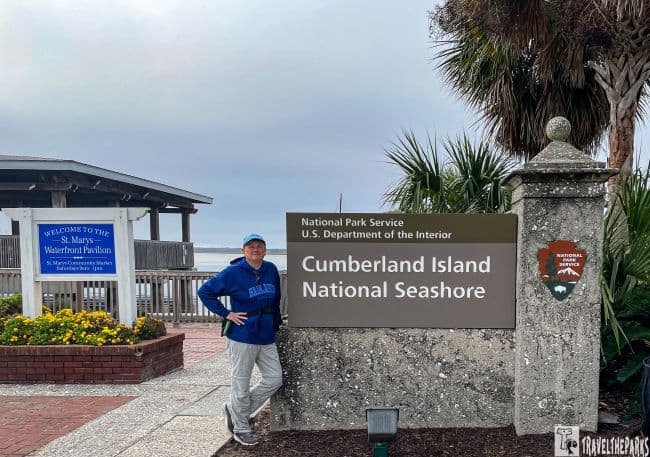
Table of Contents
Exploring Cumberland Island National Seashore
Cumberland Island is 18 miles long and 3 1/2 miles wide with 9,341 acres of salt marsh. Hundred-year-old oaks draped in Spanish moss shade many of the island trails. Like all National Parks, Cumberland Island is incredibly diverse. The island also has an abundance of wildlife- armadillos, feral horses, deer, raccoons, sea turtles, wild boars, alligators and migratory birds. Various remains and ruins are open for public viewing via the National Park Service, and provide evidence of the lavish gilded age.

You can visit the island without a tour and walk to the Dungeness Estate Ruins, hike the 50-miles of trails or just soak in the sun on the 17-miles of pristine beach.
.
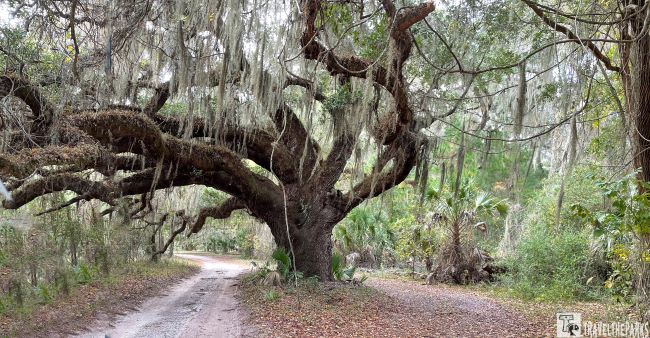
The Small-Town Charm of St Marys, Georgia
This small coastal village is the jumping off point for Cumberland Island. It is also a great central location for visiting the nearby Okefenokee National Wildlife Refuge, St. Marys Submarine Museum or Fort Pulaski National Monument or the other golden Georgia Islands of Tybee, St Simon or Jekyll.
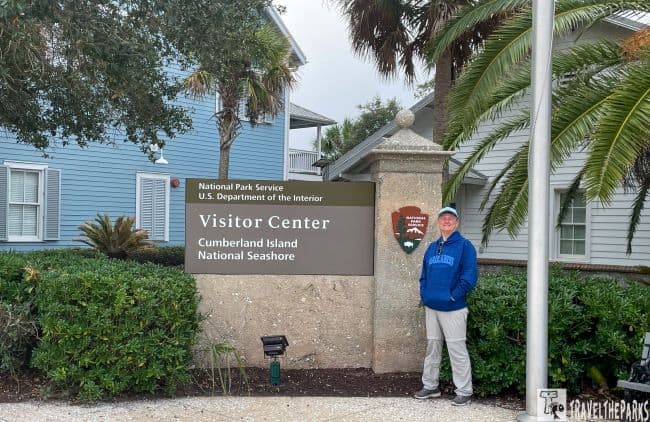
Need to Know Before You Go: Cumberland Island National Seashore
- Location: Seven miles east of St. Marys, Georgia, Cumberland Island is only accessible by boat (personal boat, private charter or ferry). Booking through the Cumberland Island Ferry website or call 877-860-6787 was relatively easy.
- The Mainland Visitor Center is open daily 8:00am to 4:30pm, Monday – Sunday (except Christmas day). The many exhibits and displays detail the history of the island, from the Native Americans to the Carnegie family. Rangers are available to answer questions and there is a bookstore, a small gift shop. Before you depart the marina, be sure to downloadable a map the Cumberland Island National Seashore.
- Parking is one block west of the visitor’s center and is free for 36-hours.
- Entrance fee for Cumberland Island National Seashore that is paid at the Cumberland Island Visitor Center prior to boarding the ferry. A ticket for an adult is $10, and a ticket for a youth or child under 16 is free. We used our The America the Beautiful Pass.
- Best time to visit: the island would be late March/early April or late September/October when the weather is cooler for hiking, occasionally windy, not ideal for the beach (fewer mosquitoes). In the summer months, the island can be hot, but the beach is a welcome respite.
- What should we bring? Remember, a good pair of sunglasses, sunscreen, towel, ball cap or wide-brimmed hat, and a light loose-fitting long-sleeved shirt for sun protection while on the trail. If you plan to walk the trails, bring bug spray for the biting insects
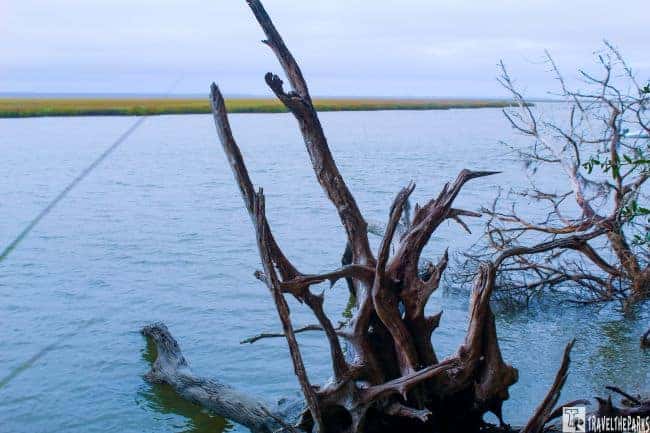
Your Gateway to Exploring Georgia’s Hidden Coastal Gem: Cumberland Island Ferry
It is a 45-minute scenic ferry ride to the island. We opted to sit in the open air seating on the top deck for most of the trip. Although it is an overcast morning, the views of the St Marys River marshes and mud flats are dramatic.
Taking the ferry over at 9:00 AM and returning at 4:45 PM was convenient for us. On the island, we had plenty of time to explore. Upon docking, there are bathrooms and water refill stations. Make sure you pack a lunch, since there are no food options on the island.

Tour Extraordinaire: From Day Trips to Guided Adventures on Georgia’s Wildest Island
- Option 1 is simply relaxing at one of the endless beaches of Cumberland Island. From either the Dungeness dock or Sea Camp dock, a series of boardwalk trails leads to the beach areas.
- There is much more than just a beach on the island. Option 2 is to do the self-guided or ranger led tours of Dungeness Estate Ruins, the Ice House Museum and the boardwalk trails.
- Option 3 is to either bring a bike (additional $10 cost for the ferry) or do a Lands and Legacies Tour Around Cumberland Island ($45). Both will take you a full day to see the northern sites on the island. Round-trip travel time is 3-5 hours for bikers or 8-10 hours for hikers.
Note: While they protect fossils and rocks in national parks, you are allowed to collect shark teeth from Cumberland Island.

Early History of Acclaimed Cumberland Island National Seashore
The earliest known inhabitance to the island were the Indigenous Tacatacuru, a Timucuan indigenous clans. They were a semi-agricultural people mainly harvesting foods from the ocean. In 1562, French explorer Jean Ribault’s expedition, they met and formed a friendly relationship with the building of Fort Caroline. Later, when the Spanish arrived in the 1564, they erected a Franciscan mission to convert the Timucuan Indians to Christianity.
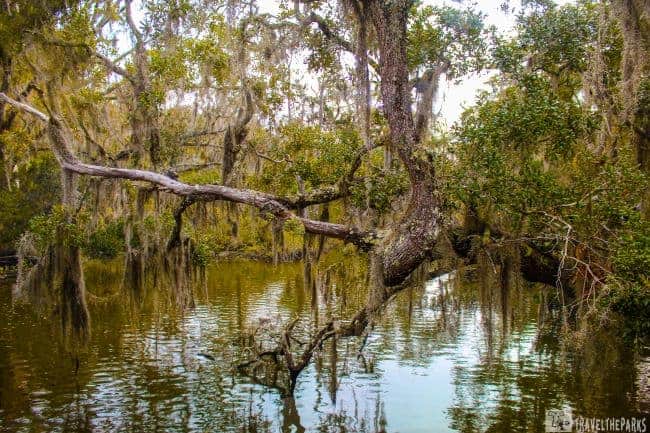
Europeans brought disease along with tribal rebellions decimated the indigenous clan. By 1700, it reduced the Timucuan population to just 1000. They abandoned the island, joining the Timucuan in North Florida.
Uncovering the British Legacy on Cumberland Island—A Hidden Chapter in Georgia’s Coastal History
The Yamasee clan arrived shortly after the Tacatacuru left. It was in 1736 that James Oglethorpe, the founder of Georgia and Fort Frederica, arrived on the island building the first lodge calling it “Dungeness.” He, along with a Yamacraw chief named the island Prince William, Duke of Cumberland. He decided they would build Fort St. Andrews in 1736 on the northern end of Cumberland Island. They abandoned it in 1742.
Revolutionary War General Nathanael Greene and his wife purchased acreage on Cumberland Island in 1783. They constructed a four story tabby home. General Nathanael Greene died in 1786, leaving a massive debt to his wife and children. Later, Phineas Miller married widow Catherine, widow completing the manor house on the island in 1803 and keeping the name “Dungeness.”
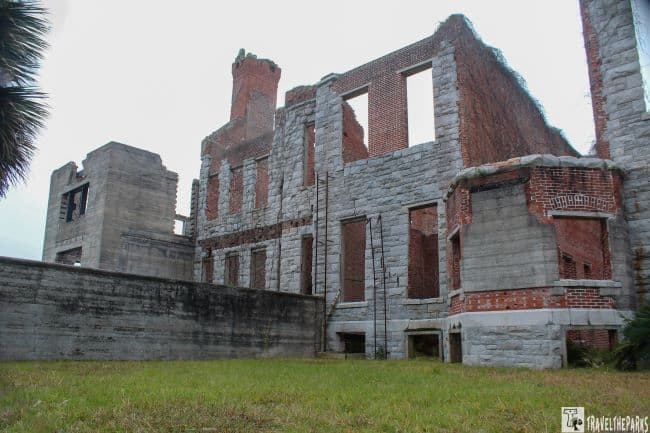
Remember: Bring binoculars or a camera with a telephoto lens
Take Excellent Lands and Legacies Tour of This Magnificent Island
You cannot see everything on foot if you come for only one day. So, we opted to purchase the 6-hour Lands and Legacies tour. It’s an absolute must if you want to maximize your time on the island. This full-day tour highlights Cumberland Island’s history from the various eras. Departing from the Sea Camp Dock, the passenger van took us the 7-miles north to see Plum Orchard mansion, the First African Baptist Church, other wilderness sites.
Tour guide Mike Fulford was an incredible historian and storyteller. His intriguing narration is a deep dive into the mythical island’s history. His anecdotal stories captured our imagination, keeping us spellbound. He had us learning about the 400 year history of the island before bringing the gilded age to life.
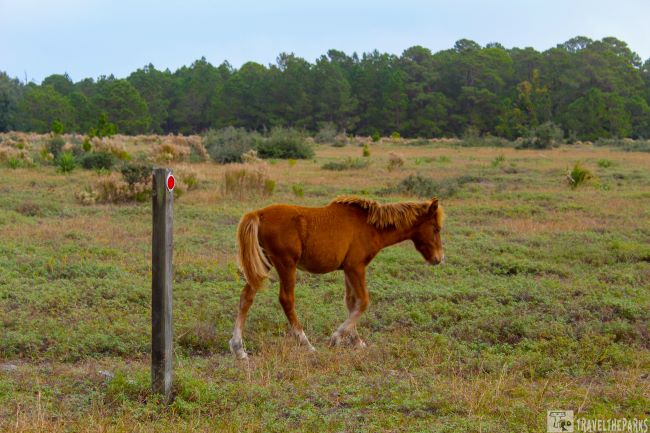
The Celebrated Feral Horses in Stafford Field
Stafford Field is the remnant of an original sea cotton plantation. Our first opportunity to see feral horses was here. In this field, a stallion and several mares with foals were feeding on grass. Burns are prescribed annually to protect structures, cultural resources, create a growing environment for grasses, and restore fire to the ecosystem. The National Park Service also maintained a weather station at this field, which also serves as an airstrip for the island families.
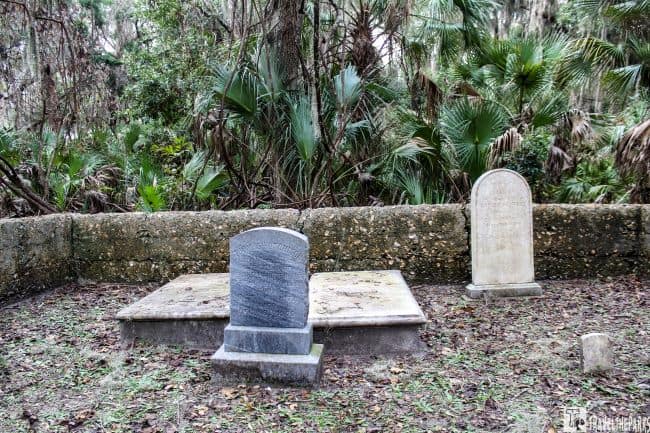
Stafford Cemetary A Must Do on Cumberland Island National Seashore
Our first stop along the 4-miles down the main road was the grave or Robert Stafford, a wealthy industrialist. Stafford died in 1877. Our group approached a coquina wall surrounding four marked graves. Beside Stafford’s grave, they also buried his mother and sister in this plot. One grave surprised us! Thomas Hutchinson, a golf professional, of St. Andrews, Scotland, born in1877. Died here on December 8, 1900, in a horse riding accident. His story was interesting, as he and Stafford never knew each other. Apparently, William Coleman Carnegie hired Hutchinson to create a private nine-hole golf course on the Stafford Plantation property. He was only 23 years old.

The Stafford Plantation Era-Cumberland Island National Seashore
Robert Stafford was an unconventional man. Born poor, he would become the leading planter on Cumberland Island. Arriving from Groton, Connecticut, in the early 19th century, he purchased the plantation, paying $11,000 for the land, which included 53 slaves on Cumberland Island. He continued to expand his land interests on Cumberland Island, eventually gaining 8,125 acres by 1859.
Stafford believed he could manage Cumberland island cotton production using a task system to meet the many specialized requirements. It was common for tasks to be measured out in quarter-acre increments. They were assigned slaves tasks such as plow fields, planting crops, picking or ginning cotton. After they completed daily tasks, the slaves were free to pursue other tasks such as hunting game in the woods, raising vegetables in the garden, or anything else they wished to do. The slaves could supplement their plantation rations, trade, or sell the products they created. A banker at heart, he encouraged his slaves to save for a rainy day. He taught them how to save and manage money.
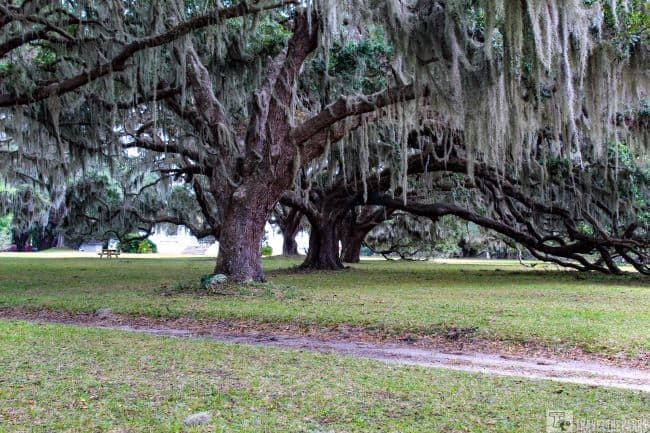
Unfortunately, his life was not without controversy. He never married, yet fathered six children with a “mixed” servant nurse named Elizabeth “Zabette” Bernardey. Stafford moved his family to Connecticut, despite the restrictive laws in Georgia. He provided for the education and safety of his children, and most were prosperous. His daughter Nancy could pass for white and became a successful physician. Upon his death in 1877, his heirs sold the plantation lands.
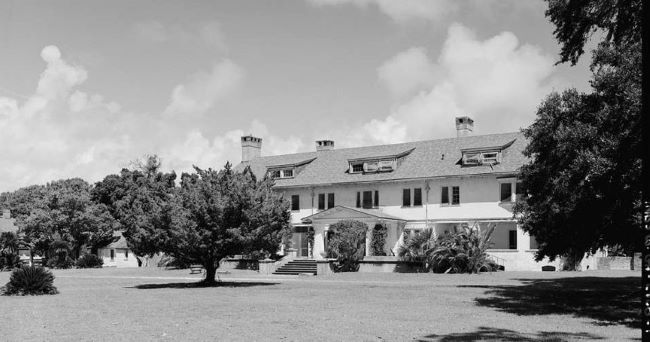
Stafford House -Cumberland Island National Seashore
A quarter mile from the Stafford House is where the slaves’ quarters were built. The only remnant remaining is a ruin known as “the Chimneys,” a collection of 24 hearths and chimneys representing the slaves’ quarters.
The Stafford House built in 1901 was purchased for William Carnegie by his mother Lucy as a wedding present from the descendants of Stafford. Today the Stafford House remains in private hands for the next 5-years ceded to become part of Cumberland Island National Seashore per an agreement with the National Park Service.

Where the Elite Escaped: The Gilded Era’s Legacy at Plum Orchard on Cumberland Island
The Plum Orchard Mansion is 7-miles from Sea Camp. They have listed this residence and surrounding area on the National Register of Historic Places. Donated to the National park service in 1972, they have beautifully restored this stately 22,000 square foot mansion. Plum Orchard open Thurs-Mon, 9am-12pm & 1pm-4pm. Closed Tues & Wed. Tours offered on the hour & last 45 minutes. Only reachable by private vessel, bicycle, on foot, or by taking our Lands and Legacies Tour.
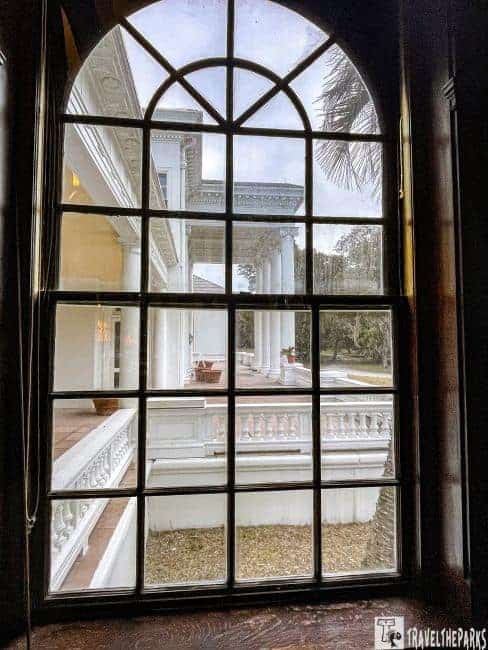
Lucy Coleman Carnegie built the mansion for her son George Lauder Carnegie and his wife Margaret Copley Thaw in 1898 as a wedding present. Peabody and Stearns designed it in the Georgian Revival style.
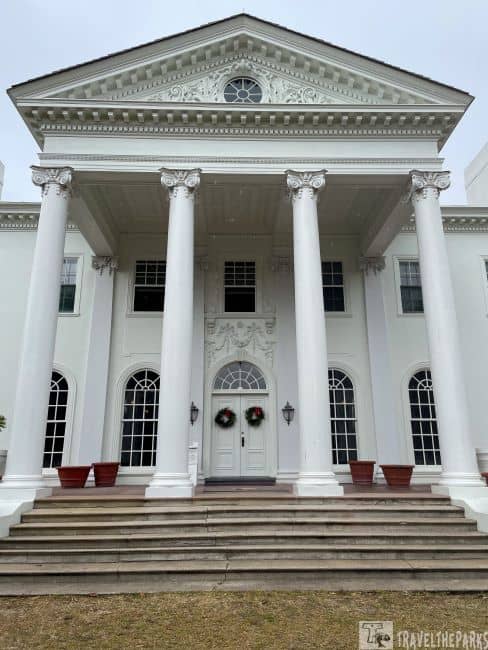
The Luxury of Plum Orchard
An architectural gem, we walked through the 30-room home, with our tour guide Mike providing an insightful narrative for each room. I really felt like I have stepped back in time. From the spectacular indoor swimming pool and squash court to the ornate original toilet used by Margaret, there is a lot to see. Being surrounded by so much wealth and privilege was very hard for me to comprehend. Imagine having 12 bathrooms. Ornate furnishings included an authentic Tiffany lamp hanging over the front hall table, burlap wall paper, imported marble tile, and a baby grand piano manufactured by William Knabe & Company, in the game & gun room.
In the years following the death of George Lauder Carnegie, his widow, Margaret Copley Thaw, remarried and moved to Lake Naivasha, Kenya (Africa). Furniture from Dungeness was used to furnish the house after Margaret sold the original furnishings.


The tour gave us a 30-minute break for lunch. We ate on one of the wraparound verandas to escape the light afternoon rain. A quick walk of the outer buildings and the river’s edge for photos before returning to the van for the later half of the tour.
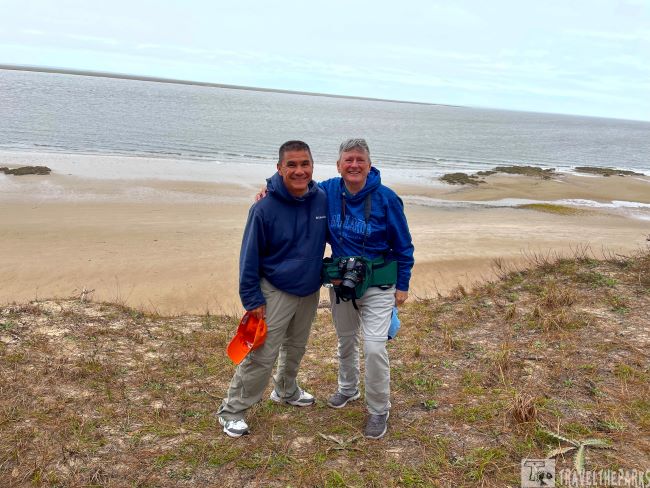
The High Point/Half Moon Bluff District
A short trail leads to Half Moon Bluff. Originally a hotel and resort complex, the High Point/Half Moon Bluff District was first developed in 1880. They listed it on the National Register of Historic Places in 1978. Wealthy people in northern and central Georgia became fond of visiting the resort hotel at High Point.
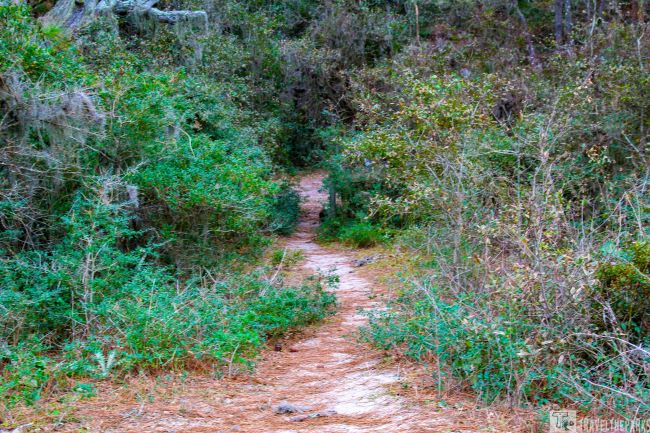
The Cumberland Company built a wharf below a steep bluff overlooking the Cumberland River. At High Point, on the north end of the island, steamboats docked at the wharf, bringing day-trippers and visitors to two hotels. They constructed a tramway shuttled guests and the supplies from the wharf area to the playground of the rich and famous (hotel complex). A slender sand beach and a few pilings are all that remain today of the original wharf.

The Forming of The Settlement of Cumberland Island
At the north end of Cumberland island (14-miles for Sea Camp), many of those enslaved by plantation owner Robert Stafford found a reprieve when they were emancipated after the Civil War. During the early 1890s, they purchased acre properties from Martin Burbank, a businessman operating a hotel at the northern end of the island. The Settlement was the name given to a small community that was formed, and two of its original buildings were open to the public. Burbanks and the other hoteliers’ intentions were to have a ready supply of labor. They wanted black families to move to the Settlement. There was zero unemployment for those wanting to work. All lived without debt as the savings encouraged during the sea cotton era by Stafford provided them with the means to purchase the land and build their homes as freemen.
The hotel resort lasted until the Great Depression spelled the end, closing it overnight. The residents of the High Point/Half Moon Bluff District slowly declined as they dispersed to the mainland. Today, the remaining homes from the resort area are privately owned by the Candler family of Atlanta heirs to the Coca Cola fortune.
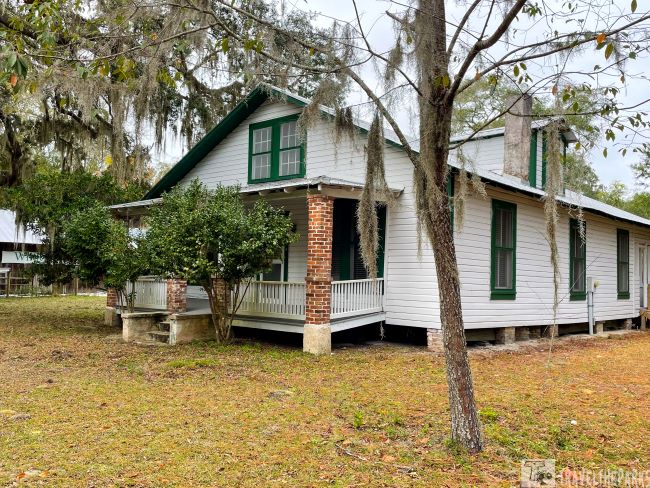
Famous but Spirited Beulah Alberty
Continuing our exploration of the remarkable legacies of American women. Beulah Alberty, a descendant of enslaved African Americans, built a small wood-framed bungalow with gabled window dormers in 1920. The National Park Service has restored the house. Mike told us that Beulah got her education at the Selden Institute in Brunswick, GA. She was initially a school teacher. After returning to the island in the 1950s and 1960s, she became a leader of the church and an advocate for the people of the community. A strong-willed entrepreneur, she was known as the “Mayor of the Settlement.” The smaller home adjacent to this house was owned by Roger Alberty. It has collapsed in on itself.

Historic First African Baptist Church & Storybook Weddings
Originally, a small church was first established in 1893. However, it burned down. They rebuilt the church in the 1930s. They rebuilt the First African Baptist Church of Cumberland Island in 1937. It was meant to serve the community as a place of worship and a schoolhouse. The initial Black property owners are gone and today the Cumberland National Seashore owns and maintains the church.

As part of the tour; we visited the tiny chapel where John Kennedy Jr. and Carolyn Bissette had their fairy-tale wedding in 1996. For years, Kennedy had been a guest of some Carnegie descendants on Cumberland Island. His choice of the island was because the paparazzi couldn’t reach him here. There is no transportation provided by the National Park Service, but anyone can get married in the church today.

Untamed: The Wildest Woman in America-the Fight for Cumberland Island
A highlight of our tour was learning the fabled story of Carol Rucdeschel, a self-educated biological specialist, wildlife activist, and pathologist, moved to Cumberland in the 1970s. Among her many contributions was assisting in the establishment of Cumberland Island National Seashore. Her concern was for feral horses and loggerhead turtles, both of which were endangered.
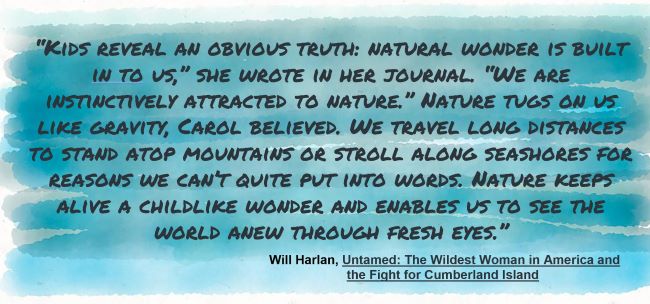
As an 81-year-old woman, Carol still lives independently on a small island. Cumberland Island is the setting for a book named “Untamed: The Wildest Woman in America.” Written by biographer Will Harlan, the book chronicles her life and her efforts on the island.
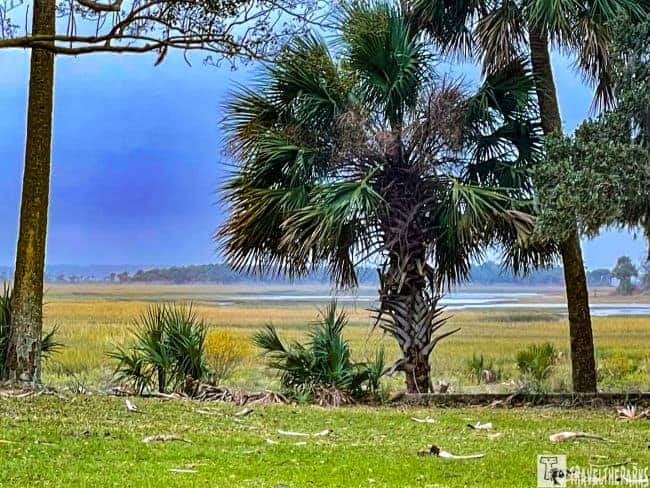
Self-guided Tour of the Extensive Dungeness Ruins
On the south end of the island, the hauntingly beautiful ruins of Lucy Carnegie’s home at Dungeness Estate are enchanting. From the Dungeness dock, it is a 0.5 mile walk to the Dungeness Ruins. The estate’s first residence, the Millers, used the land to grow Sea Island cotton. They established a tabby home similar to those seen at Kingsley Plantation at Fort George Island State Cultural Site. Using enslave labor, the Millers prospered. Catharine and Phineas Miller helped Eli Whitney develop the cotton gin, debuted in 1793. Eventually, sea cotton faded and decline, showing the end of the plantation era. The home burned in 1866.

After the American Revolution, Thomas Morrison Carnegie (brother of steel magnate Andrew Carnegie) and his wife Lucy Coleman Carnegie purchased the land. Immediately they started building the 59-room Queen Anne-style mansion in 1884. They completed construction of the Carnegie family’s winter estate in 1885.
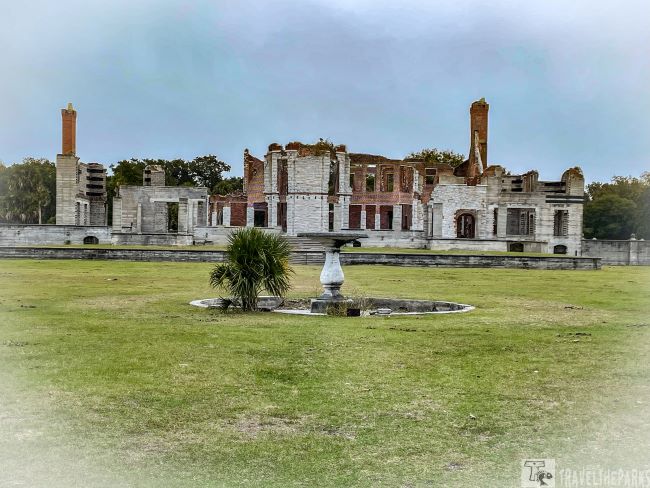
The Legacy of Lucy Coleman Carnegie
Cumberland Island has been renowned for its strong trailblazing women. The matron Lucy Carnegie was one of them. Losing her husband, Thomas M. Carnegie, at 43, he left her with 9 kids and a large island estate. Single-handedly, she made the lavish estate self-sufficient. She added to the elaborate estate to include a recreation house with an indoor pool, squash courts, a golf course, and an additional 40 living quarters for a staff of 200. She died in 1916 at 68. Here on Cumberland Island, her legacy remains. The family abandoned the Dungeness during the great depression in 1925. The mansion caught fire in 1959, leaving only the brick skeletal remains. However, the national park service has done an excellent job of preserving the remaining ruins.
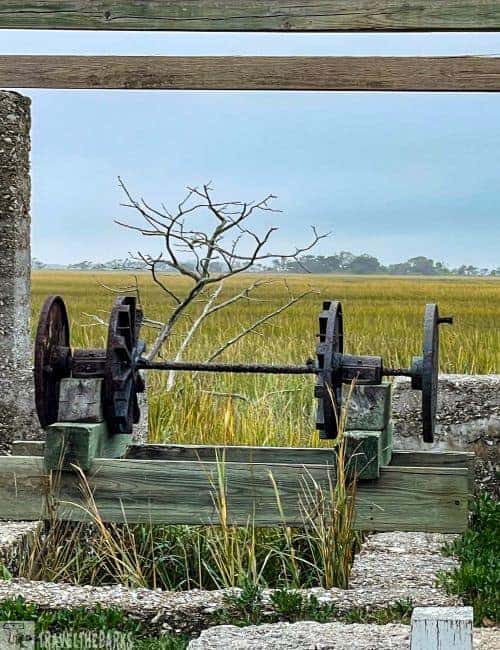
There are many outbuildings to explore around the Dungeness ruins. A greenhouse, laundry house, tennis court, cemetery and the Tabby house built by Nathaniel Greene as servants’ quarters. You could literally spend your entire afternoon just walking the Dungeness Historic District. At Cumberland Island National Seashore, you can take a cell phone audio tour of the Dungeness historical area. Each number stop gives you a brief history of each building/location.
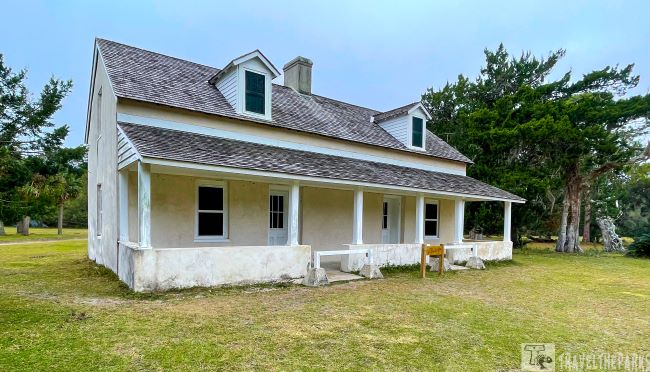
The Incredible Greene Tabby House
Greene Tabby House is the oldest standing structure on Cumberland Island. Dating to the early 1790s. The late Nathaniel Greene’s wife Catherine, and her second husband Phineas Miller, used the tabby house as the family’s temporary housing during construction of Dungeness. Later, it became the gardener’s house. Ranger’s open the tabby house for viewing after the ferry arrives in the morning. It closes before that last ferry leaves at 4:30 pm. They constructed the tabby house using centuries old slurry comprising homemade lime, sand, oyster shells and water. It was much like cement-incredibly durable.

Famed Ice House Museum
At the Dungeness dock it is open all year 8am – 4:30pm. Thomas and Lucy Carnegie built the Ice House in circa 1890 to store large shipments of ice used by the island estate. It has ventilated roof and sawdust insulation walls that are two-foot thick. The National Park Service restored the building and now serves as a small, self guided museum. There is a great selection of artifacts and photographs. Restrooms and water refill stations are also here. This is a good place to see dolphins and manatees in the summer months.
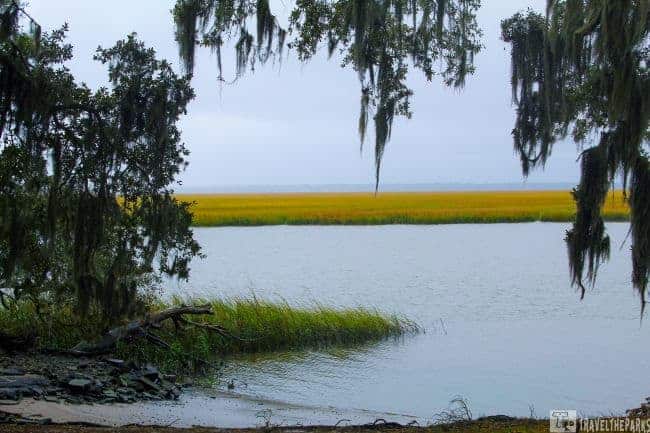
Join a Ranger Parks Program
Join a Ranger-Guided Footsteps Tour-Offered daily at 10 am. and 12:30 pm, this is a one hour, 1-mile walking tours. Knowledgeable rangers will guide you through the Dungeness ruins, highlighting the early origins of the island through to the building of the mansion.
A ranger’s Dockside program is held daily at 4:00 pm and coincides with the final ferry departure. The day we visited, kids were learning about the various sea creatures that inhabit the island.
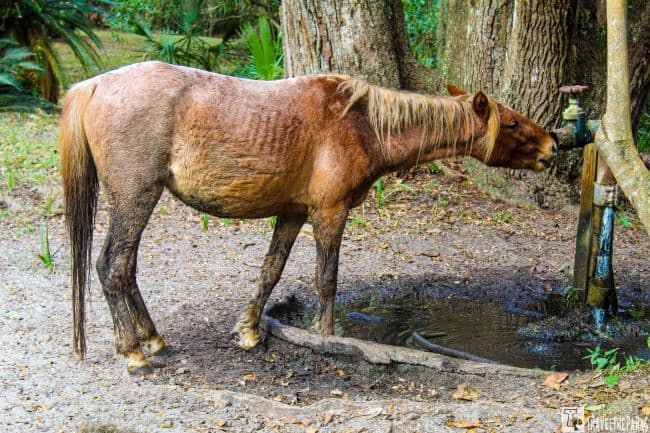
The Mythical Feral Horses of Cumberland Island National Seashore
Horses were first brought to Cumberland Island by English colonists in the 1740s to aid in the construction of forts and lodges. Later, aiming to improve herd genetics, the Carnegie family introduced Tennessee Walking Horses, Paso Finos, and Arabians to the United States during the 19th and 20th centuries. Today, the free-roaming herds are often seen grazing outside the Dungeness Estate Ruins. Never approach feral horses, they are not domesticated and should be given plenty of space.
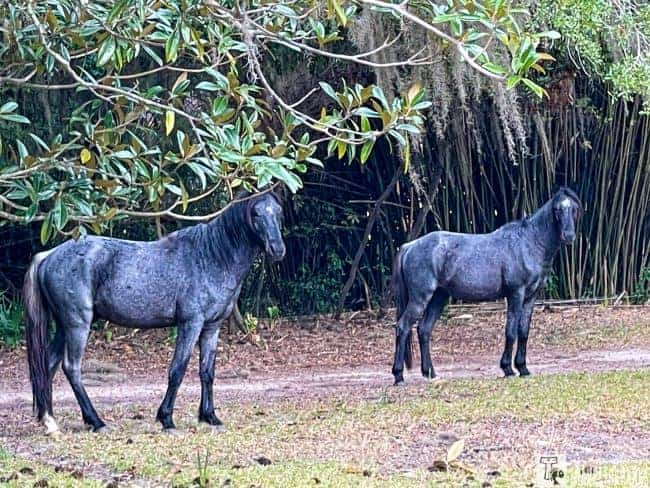
Over 50-Miles of Hiking Trails on Cumberland Island National Seashore
Hiking the Southend Loop Trail is the most popular hiking for day trippers on Cumberland Island. The loop begins with the River Trail, which is 0.8-miles, starting from the Sea Camp Dock to the Dungeness Ruins traverses through windswept oaks and palmetto. From there, take the Dungeness Trail (1.5 miles) through the Green-Miller cemetery to the boardwalk over the marsh before it reaches the dunes. The trail follows along the open sand beach before returning to Sea Camp Dock. It takes most hikers 2-4 hours to complete the entire 4.3-mile loop.

You will see plenty of wildlife. Deer and feral horses are the most common. Armadillos, wild turkeys, and migratory birds are often seen as well. The occasional feral hog, otter, or bobcat can be observed in the early mornings or late evening.
NOTE: Stay hydrated! Water bottles come in a wide variety of colors, shapes, and sizes. One gallon of water per person per day is recommended when hiking in the park.

Camping on Cumberland Island National Seashore
If you plan on camping, you need to reserve a site well in advance. Reservations can be made 6 months out to the day. The island has two main campgrounds: Stafford beach (3.5-mile walk) or Sea Camp (1/2-mile walk). It also has wilderness sites: Hickory Hill (5.5 mile walk), Yankee Paradise (7.5 mile walk) and Brickhill (10.5 miles). Prices vary between $9-$40 depending on which campsite you choose.
Note: Not one of the hike-in sites on Cumberland Island includes electricity and there are no hot showers.
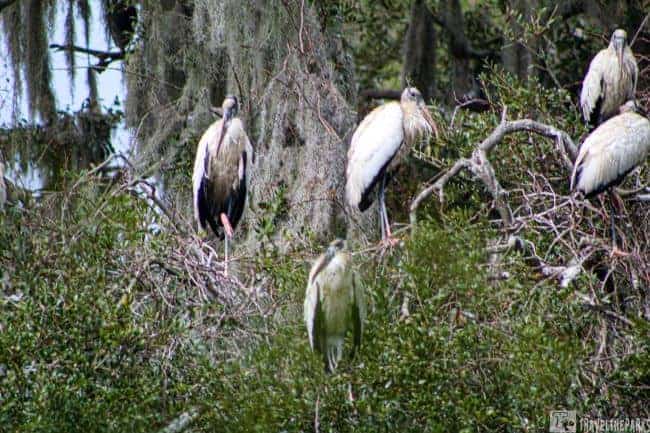
Other Lodging Options
Greyfield Inn-A two-night minimum stay is required at the historic Greyfield Inn. Rooms begin at $700 a night. As part of your stay, you will receive a free ferry ride to the island, all your meals, island excursions, equipment rentals (kayak or bikes) and can spend time with a naturalist. Lucy built the house from 1901 to 1905 for Margaret Carnegie Ricketson and her husband Oliver Ricketson. Today. members of the Carnegie family still own and manage Greyfield, the converted mansion. It opened in 1962 to the public. It includes 15 rooms in the main house, as well as two cottages.
Crooked River State Park– is just seven miles outside St. Marys, GA, and the Cumberland Island Ferry. It features campsites with electricity in a wonderful setting worth exploring after your day on the Cumberland Island National Seashore.
St Marys has a nice waterfront area with shops, restaurants, and boutique bed & breakfast hotels.
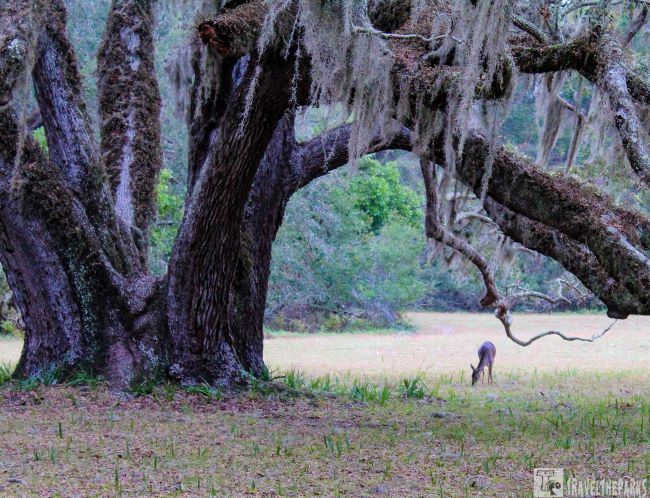
Tips for Your Trip to the Cumberland Island National Seashore
- Bring a lunch and snacks, there is no food for purchase on the island.
- Drink plenty of water during the day.
- Enjoy the wildlife, folks, but don’t get too close, please!
- There are also no trash cans–Cumberland Island is a pack in, pack out park.
- Remember, LEAVE NO TRACE pack in, pack out trash policy.
- If you take the tour, there will be 2-3 bathroom stops along the way.
- Remember to bring bug spray and check for ticks.
- Bring along your sunscreen, sunglasses, beach towels, and remember your camera.
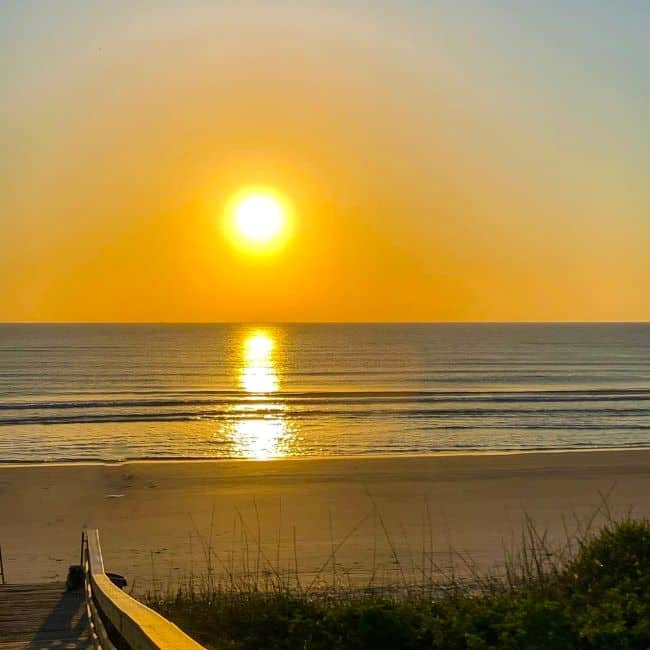
Final Thoughts: A Full Day on Legendary Cumberland Island National Seashore
As Georgia’s largest barrier island, Cumberland Island has a long and diverse history. In truth, I consider this one of the most entertainingly memorable tours I’ve taken in my many years of travelling. A magical place, Cumberland Island National Seashore, is an adventure for everyone. Whether you are a beach lover or hiker or history buff, the island is a unique experience.
The Georgia coast has lots to offer the traveler. Day trips for history buffs to Savannah, Fort Pulaski and Amelia Island’s Fort Clinch State Park are all easy proximity to Cumberland Island. You can combine Cumberland Island with a road trip down the Buccaneer Trail or the Okefenokee Swamp.
Do you recommend Cumberland Island National Seashore? What did you like best? Share your thoughts in the comments below.


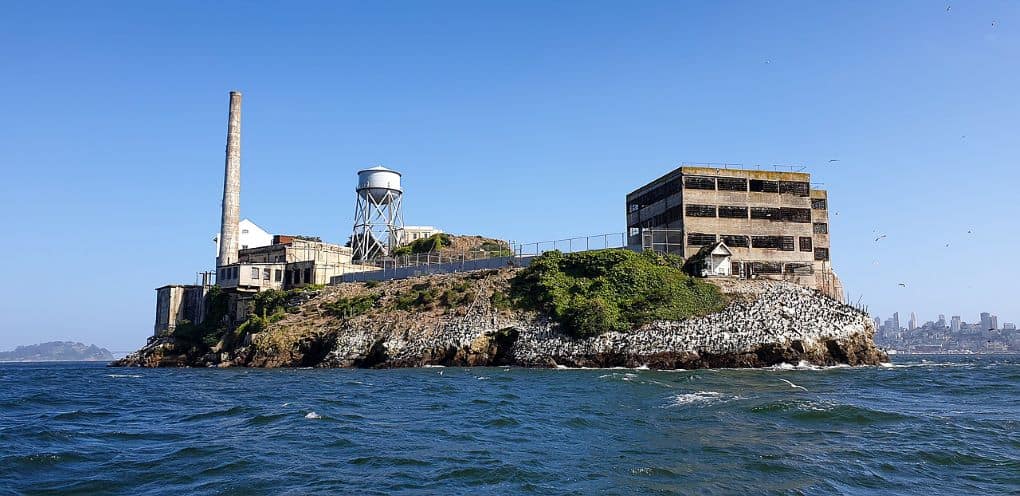
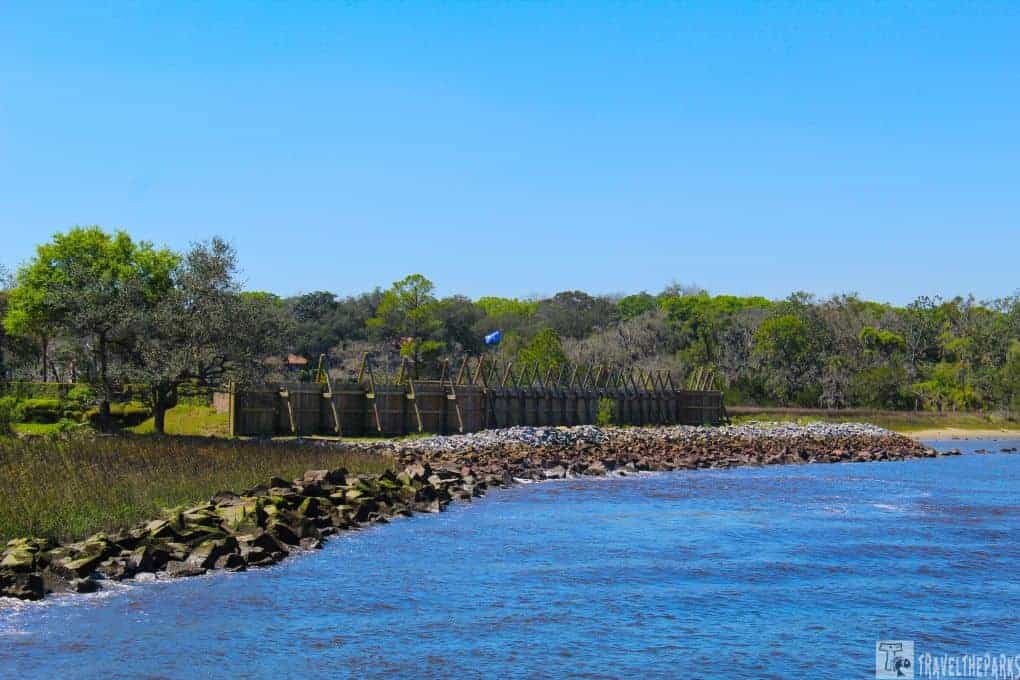
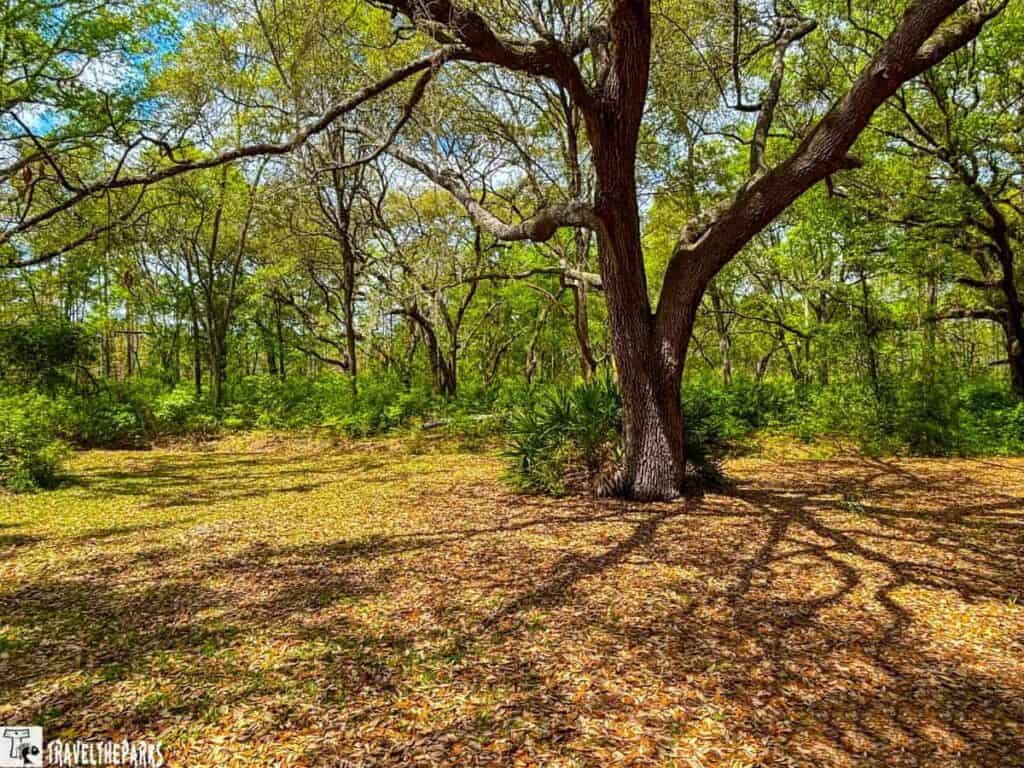
Stan Acevedo
Just wanted to say I found your blog helpful in planning our trip to Cumberland Island. Thank you!!
Travel the Parks
I am glad that you were able to use our blog to plan your trip. We love sharing what we learn on our trips to the parks and other destinations. We hope you have an amazing trip! Thanks for reading our blog.